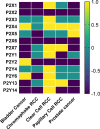P2 purinergic receptor dysregulation in urologic disease
- PMID: 35687210
- PMCID: PMC9184359
- DOI: 10.1007/s11302-022-09875-1
P2 purinergic receptor dysregulation in urologic disease
Abstract
P2 purinergic receptors are involved in the normal function of the kidney, bladder, and prostate via signaling that occurs in response to extracellular nucleotides. Dysregulation of these receptors is common in pathological states and often associated with disease initiation, progression, or aggressiveness. Indeed, P2 purinergic receptor expression is altered across multiple urologic disorders including chronic kidney disease, polycystic kidney disease, interstitial cystitis, urinary incontinence, overactive bladder syndrome, prostatitis, and benign prostatic hyperplasia. P2 purinergic receptors are likewise indirectly associated with these disorders via receptor-mediated inflammation and pain, a common characteristic across most urologic disorders. Furthermore, select P2 purinergic receptors are overexpressed in urologic cancer including renal cell carcinoma, urothelial carcinoma, and prostate adenocarcinoma, and pre-clinical studies depict P2 purinergic receptors as potential therapeutic targets. Herein, we highlight the compelling evidence for the exploration of P2 purinergic receptors as biomarkers and therapeutic targets in urologic cancers and other urologic disease. Likewise, there is currently optimism for P2 purinergic receptor-targeted therapeutics for the treatment of inflammation and pain associated with urologic diseases. Further exploration of the common pathways linking P2 purinergic receptor dysregulation to urologic disease might ultimately help in gaining new mechanistic insight into disease processes and therapeutic targeting.
Keywords: Extracellular ATP; P2X; P2Y; Prostate cancer; Purinergic receptors; Urologic disease.
© 2022. The Author(s), under exclusive licence to Springer Nature B.V.
Conflict of interest statement
The authors declare no competing interests.
Figures





References
-
- Burnstock G. Purinergic nerves. Pharmacol Rev. 1972;24:509. - PubMed
Publication types
MeSH terms
Substances
LinkOut - more resources
Full Text Sources
Medical

